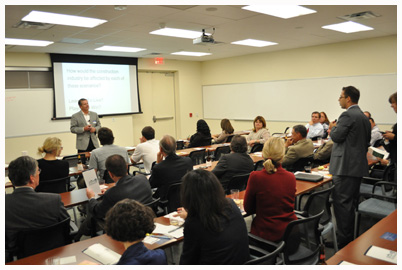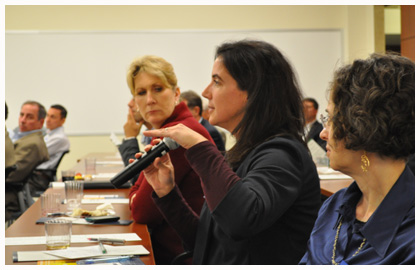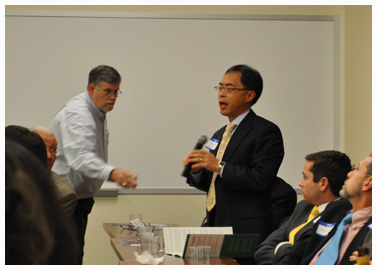 As previously reported in the Construction Citizen series about the 2040 Scenarios event, the evening included a discussion between the group of industry leaders who attended about their thoughts and reactions following the presentation of the two scenarios. The following is a transcript of the questions which Mike Holland led the discussion with, and the comments those questions generated. This is the first of two posts on this discussion.
As previously reported in the Construction Citizen series about the 2040 Scenarios event, the evening included a discussion between the group of industry leaders who attended about their thoughts and reactions following the presentation of the two scenarios. The following is a transcript of the questions which Mike Holland led the discussion with, and the comments those questions generated. This is the first of two posts on this discussion.
How would the construction industry be affected by each of these scenarios? First, how would it be affected by “Learning to Live”?
“I think we will be increasing the number of educated employees in the construction industry.”
“In the Learning to Live scenario, because of the 20 year period of confusion and stagnation, combined with the  transition to more diverse communities, I think the impact on the construction industry would be one of slowness and also diversity where there would be a lot more different kinds of projects built in the Houston area than historically. There would be diversity of projects combined with a long, very flat period. So what I heard was that there would be difference, slowness, and then opportunity.”
transition to more diverse communities, I think the impact on the construction industry would be one of slowness and also diversity where there would be a lot more different kinds of projects built in the Houston area than historically. There would be diversity of projects combined with a long, very flat period. So what I heard was that there would be difference, slowness, and then opportunity.”
“I am not in the construction industry, but what I see is that in the first scenario, everything is pretty local, and I am concerned about that. It seems that in that scenario, we are just concerned with expanding the city within its own and not really worried about the rest of the world.”
How would the construction industry be affected by “Playing to Win”?
“I am with ExxonMobil, so I am going to tie this in with the energy industry. Based on what I’ve seen in the video, the energy sector is going to be OK and flourishing. Houston is the energy capital of the world. I would think that this would also impact the construction industry by having a significant amount of projects that would come from the energy sector and help the construction industry. So with that economic impact, combined with a highly educated workforce, a higher standard workforce, and higher efficiency, I think we should have an increase in construction – a demand for higher-end construction.”
“The second scenario reminds me of an NPR story I heard just today. Speaking of global economy, we may already be  living in Houston a part of what we see in the second scenario. With the middle class slightly eroding, the second scenario looks like that trend continues. The NPR story I mentioned was talking about the United Auto Workers industry. It costs them $56 per hour including benefits to build automobiles here in this country, but in Mexico they can do it for $7 an hour. Until we, operating in a global economy, come to grips with how we deal with such incredibly depressed markets, where things are going to continue to be outsourced – to me that’s the major challenge to push scenario two back in our past, and not fall deeper and deeper into its grasp. I think from our standpoint, it’s an educational process. What are we doing to teach the trades, whether it be the “soft trades” on the design side and the engineering side, or whether it be the “hard trades”, the muddy boots guys who are going to have to know how to weld, to know how pipes are set – all of those kinds of things that you guys know. That’s going to be the challenge for us – to overcome the temptation to outsource things that can be outsourced for a fifth of the price.”
living in Houston a part of what we see in the second scenario. With the middle class slightly eroding, the second scenario looks like that trend continues. The NPR story I mentioned was talking about the United Auto Workers industry. It costs them $56 per hour including benefits to build automobiles here in this country, but in Mexico they can do it for $7 an hour. Until we, operating in a global economy, come to grips with how we deal with such incredibly depressed markets, where things are going to continue to be outsourced – to me that’s the major challenge to push scenario two back in our past, and not fall deeper and deeper into its grasp. I think from our standpoint, it’s an educational process. What are we doing to teach the trades, whether it be the “soft trades” on the design side and the engineering side, or whether it be the “hard trades”, the muddy boots guys who are going to have to know how to weld, to know how pipes are set – all of those kinds of things that you guys know. That’s going to be the challenge for us – to overcome the temptation to outsource things that can be outsourced for a fifth of the price.”
“Right now to support a population of 3.5 to 4 million people, we are averaging about 178,000 construction workers on payrolls. Plus, we can speculate how many are in the market who are not on payrolls. Yet we feel a tremendous need for more skilled craft workers. We are about to go through a generation of apprentice-trained craft workers as they exit to retire. At 7 million in the Learning to Live scenario, we’re going to need... At our peak we averaged 200,000 in 2008. We’re going to have to average 350,000 to 400,000 in the first scenario. We’re going to need 500,000+ at work in the second. We don’t have access legally, as we have had historically, to immigrant labor. Whether you talk about the Norwegians, the Irish, etc – we don’t solve that problem. We’ve got a big situation here because the construction jobs to build local facilities – even if you outsource the building of components – putting them together has to happen here. We’ve got to solve the problem of access to the workforce.”
Does anything about these scenarios seem to be a threat to the construction industry?
“The disparity of education in the second scenario.”
“The second scenario talks about the wedge between the classes – the upper class and the lower class where the middle class  is kind of disappearing. What kind of effect is that going to have on construction workers? What kind of wedge is that going to drive? We might need 500,000 workers, but are wages still going to be stagnant because unemployment is still semi-high and people are struggling to get jobs?”
is kind of disappearing. What kind of effect is that going to have on construction workers? What kind of wedge is that going to drive? We might need 500,000 workers, but are wages still going to be stagnant because unemployment is still semi-high and people are struggling to get jobs?”
Does anything about these scenarios seem to be an opportunity for the construction industry?
“In the Learning to Live scenario we have learned that not everybody has to be a lawyer, a doctor, or a CEO. That it is honorable to be a skilled construction worker. But in the Playing to Win scenario, we have a gap where if a person goes to school, he doesn’t want to be a woodworker or a drywall hanger – he wants to be a doctor or a CEO. I think that in Learning to Live we are going to make sure everyone is educated, but education is going to be redefined and is not going to be limited to people who work in those types of jobs.”
“I work for the City of Houston, and I would like to say that there is an opportunity for the construction industry to  work in neighborhoods of lower to moderate income. First, to build the infrastructure where the working class people live and work every day. Second, there is an opportunity to help the public sector find ways to help finance and create quality, energy efficient housing at a lower cost in order to help the private sector. To make the public dollars go further to finance development for senior citizens, homeless, people who want to own their first homes, people who live in apartments. We have an exploding number of senior citizens who have low to moderate incomes who need housing to live in. As these people leave their homes to live in apartments, we need a change in real estate. If the private sector can help in any way, it is to find ways to lower the cost. I see this opportunity to develop more efficient housing occurring in both of the scenarios.”
work in neighborhoods of lower to moderate income. First, to build the infrastructure where the working class people live and work every day. Second, there is an opportunity to help the public sector find ways to help finance and create quality, energy efficient housing at a lower cost in order to help the private sector. To make the public dollars go further to finance development for senior citizens, homeless, people who want to own their first homes, people who live in apartments. We have an exploding number of senior citizens who have low to moderate incomes who need housing to live in. As these people leave their homes to live in apartments, we need a change in real estate. If the private sector can help in any way, it is to find ways to lower the cost. I see this opportunity to develop more efficient housing occurring in both of the scenarios.”
“I also work for the City of Houston. The rates that we are talking about – roughly 50% in the first scenario and in the second one over twice that of our current population base. The second scenario is going to require not just a much greater quality of construction, but all the things that come from that type of rapid growth are going to require more sophisticated forms of construction. Everything from drainage infrastructure to a much higher density built environment. If that kind of talent isn’t provided, construction cannot occur, and growth will be stifled. This is both a threat and an opportunity.”
The transcript of the second half of the discussion will be included in an upcoming post.



Comments
2040 scenario industry.
Well it is not that easy I think to judge how the industry is going to be in 2040 as the technology is changing at very fast pace. God knows better where the earth is leading towards.
http://www.educationrequirements.org/construction-worker.html
2040 Scenarios for Houston
In order to motivate young people to go into the industry corruption needs to be eliminated. Employers should not be part of an education system. Education should be enforced by an independent agency with support from our government to prosecute violators. The owners/clients should demand quality work and as long as they do not demand the employers will not supply. The primary role of employers is to win contracts, not educate workers. Filling in positions with unqualified workers and cheating systems is priority over quality work. Owners have to buy it because there is nothing better. People policing themselves are prone to fall in the temptation of corruption. As long as corruption exists, cliques will have the power in making decisions who works and who doesn’t disregarding education and/or experience of a candidate. In today’s world, control is priority over quality and production. As long as this system exists education programs will be working in circles. We are worst than thirty years ago and we will be worse than today in 2040 if those in charge keep “looking the other way” and not admit the problem.
Ricardo Charles
Author “ Mexican cliques in construction”
Add new comment